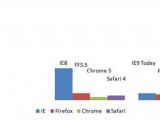While just a single month into the development of Internet Explorer 9, Microsoft has opened up to participants at the Professional Developers Conference 2009 in Los Angeles, and subsequently to the world, revealing the first details about the next generation of IE. Steven Sinofsky, president, Windows and Windows Live Division noted that there were three key areas of interest in developing IE9, namely standards support, performance improvements, and the introduction of hardware acceleration.
Dean Hachamovitch, general manager, Internet Explorer, has shared the results of the SunSpider test involving a very early development build of Internet Explorer 9, as well as pre-release versions of rival products, such as Firefox 3.6 and Google Chrome 4.0. As you can see from the chart below, IE9 is miles away from IE7 and IE8 in terms of performance, and almost matching in speed the latest versions of Firefox and Chrome.
“It is worth noting that once the differences are this small, the other subsystems that contribute to performance become much more important, and perceiving the differences may be difficult on real-world sites. That said, we remain committed to improving script performance,” Hachamovitch explained. “We’re looking at the performance characteristics of all the browser sub-systems as real-world sites use them. Our goal is to deliver better performance across the board for real-world sites, not just benchmarks.”
In terms of standards support Microsoft indicated that IE9 would follow in the footsteps of its predecessor, IE8. Just three weeks old, IE9 already bests Internet Explorer 8 in the Acid3 Test and the promise is that it will move much higher past the current 32/100 score.
“Some standards tests – like Acid3 – have become widely used as shorthand for standards compliance, even with some shortcomings. Acid3 tests about 100 aspects of different technologies (many still in the “working draft” stage of standardization), including many edge cases and error conditions,” Hachamovitch added. “As we improve support in IE for technologies that site developers use, the score will continue to go up.”
With the advent of Internet Explorer 9, Microsoft will change the way that the browser leverages the hardware and Windows resources available. Hachamovitch noted that the evolution toward IE9 implies taking advantage of the DirectX family of Windows APIs, among them Direct2D and DirectWrite.
“Graphics hardware acceleration means that rich, graphically intensive sites can render faster while using less CPU. (This interview includes screen captures of a few examples.) Now, web developers can take advantage of the hardware ecosystem’s advances in graphics while they continue to author sites with the same interoperable standards patterns they’re used to,” Hachamovitch said.

 14 DAY TRIAL //
14 DAY TRIAL // 
